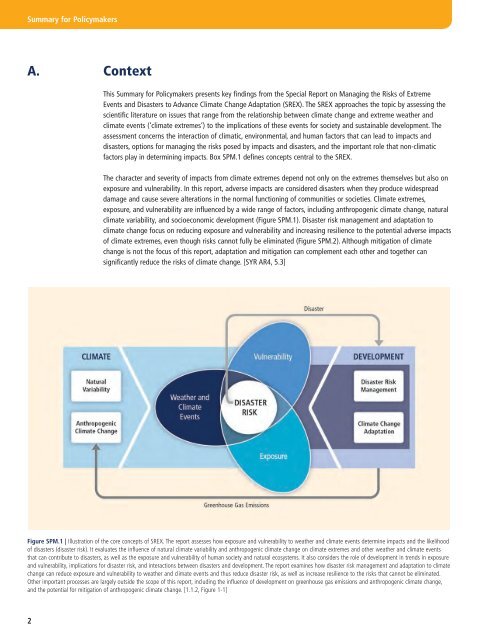Summary for Policymakers - IPCC
Summary for Policymakers - IPCC
Summary for Policymakers - IPCC
You also want an ePaper? Increase the reach of your titles
YUMPU automatically turns print PDFs into web optimized ePapers that Google loves.
<strong>Summary</strong> <strong>for</strong> <strong>Policymakers</strong><br />
A.<br />
Context<br />
This <strong>Summary</strong> <strong>for</strong> <strong>Policymakers</strong> presents key findings from the Special Report on Managing the Risks of Extreme<br />
Events and Disasters to Advance Climate Change Adaptation (SREX). The SREX approaches the topic by assessing the<br />
scientific literature on issues that range from the relationship between climate change and extreme weather and<br />
climate events (‘climate extremes’) to the implications of these events <strong>for</strong> society and sustainable development. The<br />
assessment concerns the interaction of climatic, environmental, and human factors that can lead to impacts and<br />
disasters, options <strong>for</strong> managing the risks posed by impacts and disasters, and the important role that non-climatic<br />
factors play in determining impacts. Box SPM.1 defines concepts central to the SREX.<br />
The character and severity of impacts from climate extremes depend not only on the extremes themselves but also on<br />
exposure and vulnerability. In this report, adverse impacts are considered disasters when they produce widespread<br />
damage and cause severe alterations in the normal functioning of communities or societies. Climate extremes,<br />
exposure, and vulnerability are influenced by a wide range of factors, including anthropogenic climate change, natural<br />
climate variability, and socioeconomic development (Figure SPM.1). Disaster risk management and adaptation to<br />
climate change focus on reducing exposure and vulnerability and increasing resilience to the potential adverse impacts<br />
of climate extremes, even though risks cannot fully be eliminated (Figure SPM.2). Although mitigation of climate<br />
change is not the focus of this report, adaptation and mitigation can complement each other and together can<br />
significantly reduce the risks of climate change. [SYR AR4, 5.3]<br />
Figure SPM.1 | Illustration of the core concepts of SREX. The report assesses how exposure and vulnerability to weather and climate events determine impacts and the likelihood<br />
of disasters (disaster risk). It evaluates the influence of natural climate variability and anthropogenic climate change on climate extremes and other weather and climate events<br />
that can contribute to disasters, as well as the exposure and vulnerability of human society and natural ecosystems. It also considers the role of development in trends in exposure<br />
and vulnerability, implications <strong>for</strong> disaster risk, and interactions between disasters and development. The report examines how disaster risk management and adaptation to climate<br />
change can reduce exposure and vulnerability to weather and climate events and thus reduce disaster risk, as well as increase resilience to the risks that cannot be eliminated.<br />
Other important processes are largely outside the scope of this report, including the influence of development on greenhouse gas emissions and anthropogenic climate change,<br />
and the potential <strong>for</strong> mitigation of anthropogenic climate change. [1.1.2, Figure 1-1]<br />
2

















